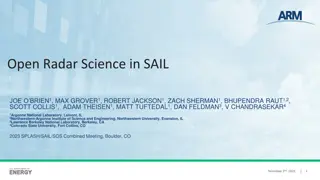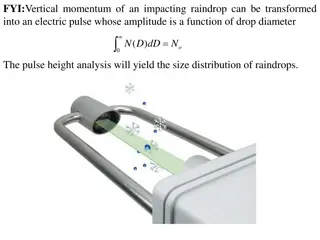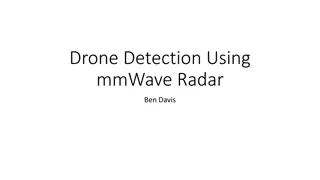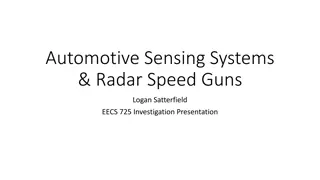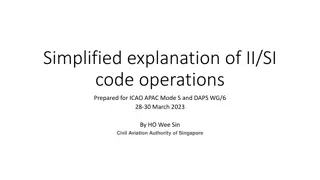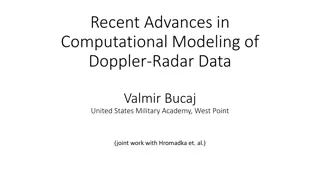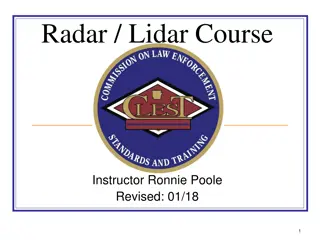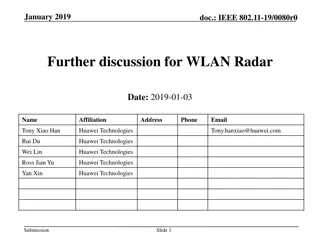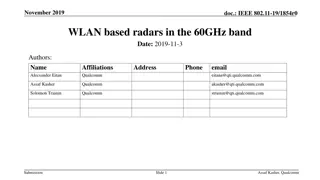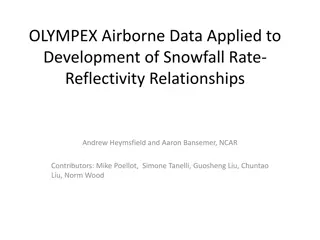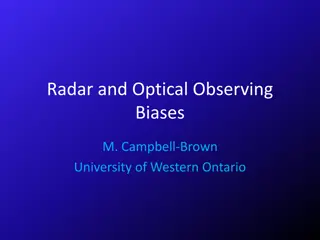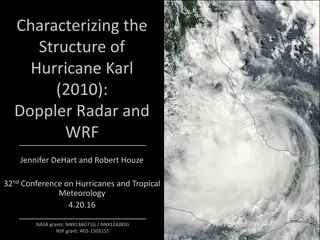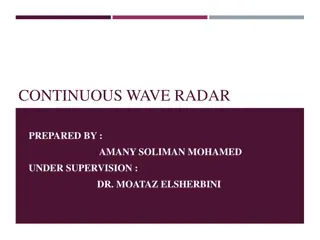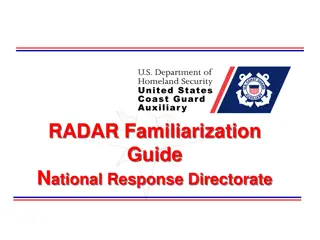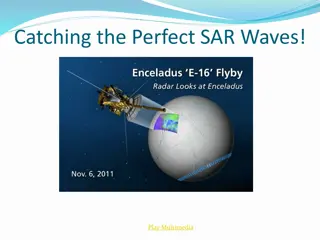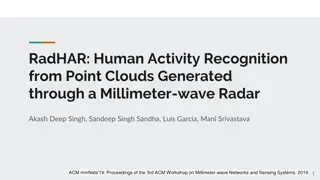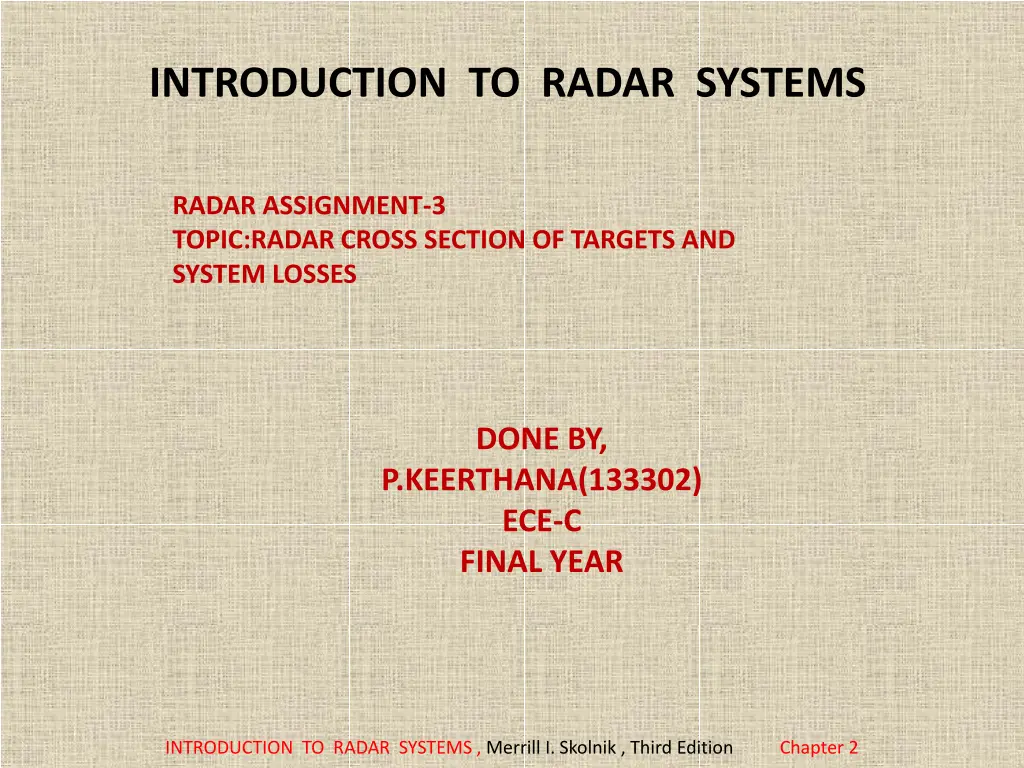
Radar Systems Analysis: Cross Section and System Losses
Explore radar cross section of targets, system losses, radar equation, signal detection in noise, receiver noise, probability concepts, and false alarm probabilities in radar systems based on Merrill I. Skolnik's book. Gain insights into radar design considerations and performance evaluation.
Download Presentation

Please find below an Image/Link to download the presentation.
The content on the website is provided AS IS for your information and personal use only. It may not be sold, licensed, or shared on other websites without obtaining consent from the author. If you encounter any issues during the download, it is possible that the publisher has removed the file from their server.
You are allowed to download the files provided on this website for personal or commercial use, subject to the condition that they are used lawfully. All files are the property of their respective owners.
The content on the website is provided AS IS for your information and personal use only. It may not be sold, licensed, or shared on other websites without obtaining consent from the author.
E N D
Presentation Transcript
INTRODUCTION TO RADAR SYSTEMS RADAR ASSIGNMENT-3 TOPIC:RADAR CROSS SECTION OF TARGETS AND SYSTEM LOSSES DONE BY, P.KEERTHANA(133302) ECE-C FINAL YEAR INTRODUCTION TO RADAR SYSTEMS , Merrill I. Skolnik , Third Edition Chapter 2
The Simple form of Radar Equation 1 P G A 4 = = ( , , , , ) t e R f P G A S ( ) max min t e 2 4 S min e A is radar cross section is effective aperture of antenna tP is peak power G is gain of antenna S Minimum of detectable signal by receiver min Target parameter Under control of Radar designer INTRODUCTION TO RADAR SYSTEMS , Merrill I. Skolnik , Third Edition Chapter 2
The failure of Simple Form 1. 2. 3. 4. Statistical nature of Smin (determined by reciever noise). Fluctuation of radar cross section. Losses. Propagation effects (earth s surface, weather and atmosphere) The probability of detection : Pd Therefore: and The probability of false alarm : Pfa must be considered. = ( , , , , , , ) R f P G A S P P max min t e d fa This mean: INTRODUCTION TO RADAR SYSTEMS , Merrill I. Skolnik , Third Edition Chapter 2
Detection of Signal in Noise Threshold Detection : A-scope presentation (amplitude versus time or range) INTRODUCTION TO RADAR SYSTEMS , Merrill I. Skolnik , Third Edition Chapter 2
Receiver Noise k T B Thermal Noise Power: N S in N N noise out of practical receiver = = = out B in F n S noise out of ideal receiver at T k T G out 0 0 n a N out S in N S k T B F S F = in = = out 0 S k T BF n n out S n S in min 0 n N N out out out min N out P G A = 4 max t e R ( ) ( )min 2 4 / k T BF S N 0 n INTRODUCTION TO RADAR SYSTEMS , Merrill I. Skolnik , Third Edition Chapter 2
Probability Density Functions (PDF) INTRODUCTION TO RADAR SYSTEMS , Merrill I. Skolnik , Third Edition Chapter 2
Probability of False Alarm Envelope Detector: 2 1 v = ( ) exp n p v 2 = n v Probability of Noise Voltage in input of IF stage is Gaussian PDF : n 0 2 2 0 0 2 R R = ( ) exp p R Mr. Rice has shown that the noise in output of IF is Rayleigh : 2 0 0 2 2 R R V = = ( ) exp exp T p V R dR Probability of False Alarm : T 2 2 V T 0 0 0 2 V = exp T P fa 2 0 INTRODUCTION TO RADAR SYSTEMS , Merrill I. Skolnik , Third Edition Chapter 2
Probability of False Alarm N = t 2 k 1 B V 1 = = = exp T 1 T k P fa fa N 2 T B = T 0 fa k 1 k INTRODUCTION TO RADAR SYSTEMS , Merrill I. Skolnik , Third Edition Chapter 2
Probability of False Alarm INTRODUCTION TO RADAR SYSTEMS , Merrill I. Skolnik , Third Edition Chapter 2
Probability of Detection + 2 2 R R A RA RA Zero-order Modified Bessel Function = ( ) exp ( ) ps R I ( ) I Rice Probability density function 0 0 2 0 0 0 0 + 2 2 R R A RA = = V ( ) exp ( ) P p R I dR 0 d T 2 V T 0 0 0 INTRODUCTION TO RADAR SYSTEMS , Merrill I. Skolnik , Third Edition Chapter 2
Integration of Radar Pulses is Rotate Per Minute (rpm) of Antenna r pf is Pulse Repetition frequency (PRF) of Radar is Half Power Beam Width (HPBW) of Antenna B n is number of pulse per scan ( hit per scan ) sec 60 60 sec 360 = = B B x r 6 360 = ? x r r B x is time on target 1 sec f p = B n f = P ? B n 6 r 6 r INTRODUCTION TO RADAR SYSTEMS , Merrill I. Skolnik , Third Edition Chapter 2
Integration of Radar Pulses Types of Integration: 1. Pre-detection integration (Coherent integration ). 2. Post-detection integration (Non-coherent integration ). 1. Pre-detection integration needs to phase of pulses. 2. Post-detection integration don t need to phase of pulses ( / ) S ( N = ( ) 1 E n Integration Efficiency : i / ) n S N N = ( ) ( ) I n n E n Integration Improvement Factor : i i 1 = ( ) 10 log L n J. I. Marcum, 1954, Rand Corporation report Integration Loss: i ( ) E n i INTRODUCTION TO RADAR SYSTEMS , Merrill I. Skolnik , Third Edition Chapter 2
Integration of Radar Pulses 1 ( ) P G A n E n 4 = t e i R ( ) max 2 4 ( / ) kT BF S N 0 1 n INTRODUCTION TO RADAR SYSTEMS , Merrill I. Skolnik , Third Edition Chapter 2
The Radar Cross Section 2 E Reflected power towa source rd unit solid angle = = r 2 4 R 2 Incident power density 4 E i Types of Targets: Simple targets such as: Sphere, Cylinder, Flat plate, Rod, Ogive and cone Complex targets such as: Aircraft, Ship, Building, INTRODUCTION TO RADAR SYSTEMS , Merrill I. Skolnik , Third Edition Chapter 2
The Radar Cross Section Sphere : INTRODUCTION TO RADAR SYSTEMS , Merrill I. Skolnik , Third Edition Chapter 2
The Radar Cross Section Aircraft : INTRODUCTION TO RADAR SYSTEMS , Merrill I. Skolnik , Third Edition Chapter 2
The Radar Cross Section INTRODUCTION TO RADAR SYSTEMS , Merrill I. Skolnik , Third Edition Chapter 2
The Radar Cross Section INTRODUCTION TO RADAR SYSTEMS , Merrill I. Skolnik , Third Edition Chapter 2
The Radar Cross Section Ships: 1 3 = 52 f D 2 2 f frequency (MHz) D ship displacement (kiloton) INTRODUCTION TO RADAR SYSTEMS , Merrill I. Skolnik , Third Edition Chapter 2
The Radar Cross Section Ships: INTRODUCTION TO RADAR SYSTEMS , Merrill I. Skolnik , Third Edition Chapter 2
The Radar Cross Section Missiles: INTRODUCTION TO RADAR SYSTEMS , Merrill I. Skolnik , Third Edition Chapter 2
The Radar Cross Section INTRODUCTION TO RADAR SYSTEMS , Merrill I. Skolnik , Third Edition Chapter 2
Radar Cross-Section Fluctuations INTRODUCTION TO RADAR SYSTEMS , Merrill I. Skolnik , Third Edition Chapter 2
Radar Cross-Section Fluctuations N = + = + ( ) sin( 2 ) sin( 2 ) s t a f t A f t r i i = 1 i target ( ) 1t s ( ) s 2t ) ( 3t s (t ) sN INTRODUCTION TO RADAR SYSTEMS , Merrill I. Skolnik , Third Edition Chapter 2
Radar Cross-Section Fluctuations Swerling Target Models: Case 0: No-Fluctuation in radar cross section occurs. Case 1: Scan to Scan Fluctuation (Rayleigh scattering ) or slow Fluctuation with PDF: 1 = ( ) exp( ) 0 p av av Case 2: Pulse to Pulse Fluctuation or Fast Fluctuation with same PDF of case 1: Scan to Scan Fluctuation with PDF: Case 3: 4 2 = ( ) exp( ) 0 p 2 av av Swerling assume that target is very big and contain many small targets Case 4: Pulse to Pulse Fluctuation or Fast Fluctuation with same PDF of case 3: INTRODUCTION TO RADAR SYSTEMS , Merrill I. Skolnik , Third Edition Chapter 2
Radar Cross-Section Fluctuations INTRODUCTION TO RADAR SYSTEMS , Merrill I. Skolnik , Third Edition Chapter 2
Radar Cross-Section Fluctuations 1 ( ) L = e n L Fluctuations loss : f f Radar Cross-Section Loss in radar equation: 1 4 ( ) P G A n E n = t e i R max 1 ( ) L ( ) 2 e n 4 ( / ) kT BF S N 0 1 n f INTRODUCTION TO RADAR SYSTEMS , Merrill I. Skolnik , Third Edition Chapter 2
Radar Cross-Section Fluctuations Decorrelation by frequency Diversity & Agility : Frequency Diversity: Multiple TX/RX in different frequency is used. Example is air traffic control radar for reliability of detection. Frequency Agility: Pulse to Pulse change in radar frequency by a wide band TX. It don t used for MTI radars. INTRODUCTION TO RADAR SYSTEMS , Merrill I. Skolnik , Third Edition Chapter 2
PRF (Pulse Repetition Frequency) c = = 2 R c T un f P c = f P 2 R un INTRODUCTION TO RADAR SYSTEMS , Merrill I. Skolnik , Third Edition Chapter 2
Antenna Parameters 2 2 26000 26000 4 4 = = 10 log G G = = G A A Gain : or dB e a B B B B = = 65 65 is vertical beam width is horizontal beam width B B D D v h power radiated in and direction unit solid angle ( , = ) G power accepted by antenna 4 = ( , ) ( , ) G D A D is directivity of antenna Power radiated in and direction unit solid angle ( , = ) D Power radiated by antenna 4 INTRODUCTION TO RADAR SYSTEMS , Merrill I. Skolnik , Third Edition Chapter 2
Antenna Parameters ( , ) G Beam Shape : Bor = Typical values 1 = = 3 deg . 30 deg , . 1 deg . Pencil Beam : Fan Beam : B B B Typical values INTRODUCTION TO RADAR SYSTEMS , Merrill I. Skolnik , Third Edition Chapter 2
Antenna Parameters ( ) ( = 2 ) 0csc G G Cosecant Squared Beam: ( ) 4 k R 2 2 4 csc P G ( ) Pr= =h 1 csc = = t P k ( ) 4 h 1 r 3 4 R 4 R Height Antenna Pattern 1T 2T 2 R 1 R h h TX/RX Range = P P arg 1 arg 2 r T et r T et INTRODUCTION TO RADAR SYSTEMS , Merrill I. Skolnik , Third Edition Chapter 2
Antenna Parameters Cosecant Squared Beam: INTRODUCTION TO RADAR SYSTEMS , Merrill I. Skolnik , Third Edition Chapter 2
Antenna Parameters Revisit Time : Scan rime of antenna Rotate Per Minute (RPM) r is depending to : 1. 2. Number of pulse for suitable signal to noise. Target speed. r Practical value for is : r 5-6 rpm for long range air traffic control radars. 10-15 rpm for long range military radars. 30-60 rpm for high speed targets. INTRODUCTION TO RADAR SYSTEMS , Merrill I. Skolnik , Third Edition Chapter 2

